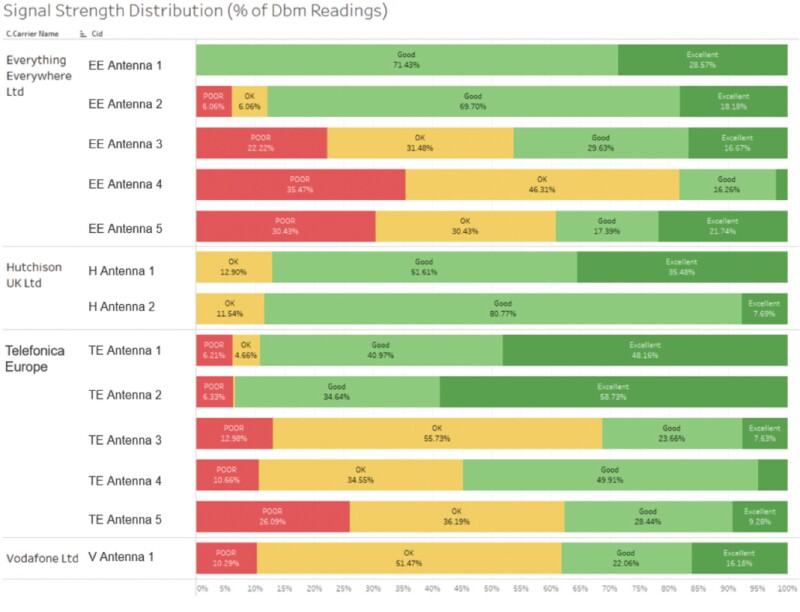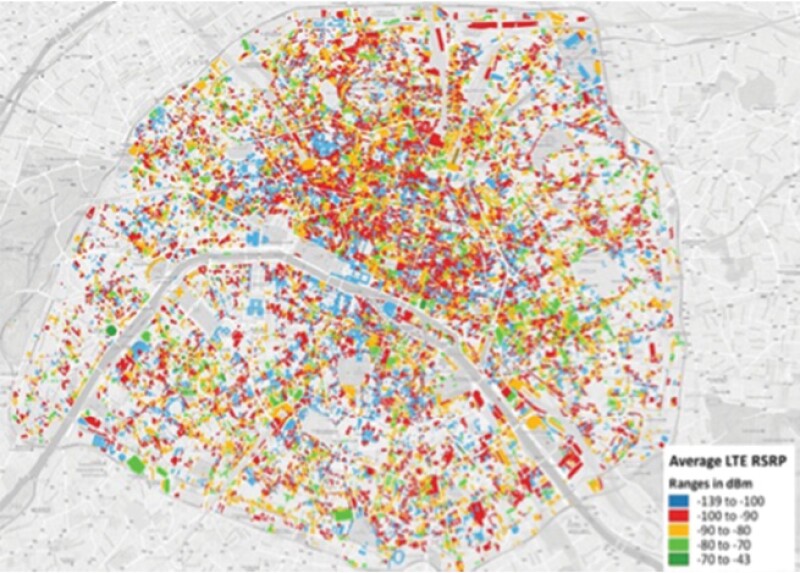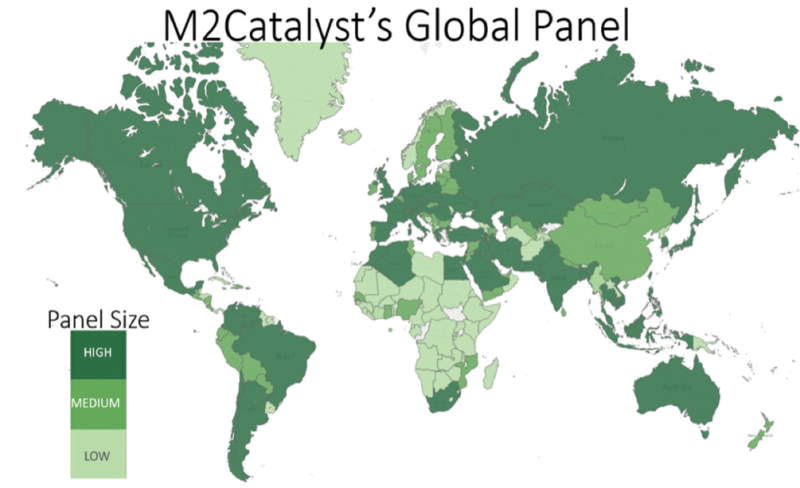Network planners at MNOs don’t get out of bed in the morning excited about leasing your towers. They get out of bed in the morning excited about leveraging your towers to connect new customers and to improve the customer experience for existing customers. It’s time to stop selling MNOs “vertical real estate” and start selling them solutions to their problems. M2Catalyst proposes a new way of selling co-locations – and a new way of valuing towers. Introducing a new business intelligence tool available through TowerXchange, Crowd SiteIntel, which enables towercos and MNOs to better understand the locations, performance, and technologies of the towers and small cell sites in a given country, and which MNOs are tenants on each. The new service is driven by M2Catalyst’s crowdsourcing platform, which provides trillions of network measurements across 200 countries and 800 carrier networks, enabling Crowd SiteIntel users to identify opportunities to improve coverage and capacity, including in-building.
TowerXchange: What can M2Catalyst do for tower companies?
Mike Brough, CEO, M2Catalyst:
Tower companies, and their investors, can use our data to reveal not just the location of their towers, but the location of competing sites throughout the country. We can also provide insights into how many tenants are on each tower, the performance of each base station in terms of signal strength, signal quality, and signal to noise ratio, and we are increasingly able to report the spectrum bands and channels in use at each base station.
The latest M2Catalyst data collection system is now enabling us to start distinguishing between an LTE tower sector containing low-frequency base stations (sectors) designed for longer distance and building penetration, and high-frequency base stations (sectors) on the same tower.
We also have historical data to track 4G rollouts, or the removal of 2G antennas. We can show trends in network performance as signal quality and strength improves or degrades, perhaps because a new building has gone up creating a blockage or interference. In the near future, as 5G begins to roll out, it will be a critical advantage for tower companies to know which carriers are deploying 5G, how quickly, and in which cities.
TowerXchange: How does it work?
Mike Brough, CEO, M2Catalyst:
M2Catalyst is a Mobile Business Intelligence (MBI) provider of customised data and actionable insights for business optimisation and expansion purposes. M2’s Crowdsourced Data Aggregation Platform captures trillions of data points on network, device, and application performance for a unique integrated global view of the mobile arena across 200 countries. M2’s MBI Platform uses machine learning, statistical inference, historical global crowdsourced data contributions, and predictive analytics to derive new insights into consumer experience, preferences, and behaviors.
TowerXchange: What can M2Catalyst do for MNOs?
Mike Brough, CEO, M2Catalyst:
As the number of wireless devices and their appetite for high speed data steadily increases, wireless carriers must continuously assess and improve the speed, quality, and coverage of their networks. Wireless carriers periodically assess their network performance by measuring signal strength and quality, and noise and interference levels throughout their network, with drive-by and walk-through testing. These methods are limited and allow only a single snapshot of their own network at one point in time and under the conditions imposed by the current user location and activity at that time. Drive-by and walk-through testing is expensive, and costs grow in proportion to how often testing is performed. The M2 Crowdsourced solution solves this market problem by gathering massive quantities of network performance data, continuously across all networks.
TowerXchange: And what are some of M2Catalyst’s capabilities that may be of particular interest to towercos?
Mike Brough, CEO, M2Catalyst:
Speed of tower analysis is one of the key benefits that the M2Catalyst data can provide. The Crowd SiteIntel offering, based on the M2 Crowdsourced data, can be provided in almost real-time, because the data has already been gathered from the market. Whether a towerco, MNO or tower real estate investor is looking for a quick analysis of a single area, a small group of towers, or ongoing access to a dashboard of all the towers in a country or region, this can be provided with amazing speed.
In Figure One, you can see a tower in Manchester, UK that has four MNO tenants and 13 base station sectors. The crowdsourced data reveals that Telefonica and Everything Everywhere each have five base stations on the structure, while Hutchinson has two and Vodafone has just one base station (sector). This image shows how the Crowd SiteIntel service can be offered at a micro level for a local analysis of a specific tower and potential competing towers in the area.
Figure one

In Figure Two, the M2 data shows the signal strength performance of each base station (sector) on the tower over the last three-month period, with dark green indicating the best and red being poor.
Figure two

The M2 data enables far deeper analysis of this tower, such as showing the trends in signal readings on LTE from historical averages to the current 71%. Another interesting metric is to look at connections to the tower based on the time of day for each MNO, to help build a better understanding of potential capacity requirements.
Figure three

TowerXchange: What are the five key metrics you can provide, and how can these help inform a towerco or MNO where they need to locate a new tower, or where there might be more demand for co-locations on existing towers?
Mike Brough, CEO, M2Catalyst:
The M2Catalyst data collection is extremely robust gathering over 10,000 data points per user per day. The data collection covers all network, device and app performance and usage metrics with corresponding location readings for each data point collected. The five key metrics required for cell tower performance and location prediction are gathered for all carriers in a city, country or region to quickly compare the cell tower needs for any area. Each base station on the tower can be measured for trending performance over time:
- Signal strength
- Signal quality
- Signal to noise ratio
- Technology usage trends for each base station for each MNO
- Indoor and outdoor competitive carrier comparisons for all above metrics
These five metrics can be quickly visualised on a heat map to pinpoint the areas where the cell towers are or will be required. Heat maps can also be generated for a single carrier in an area, comparing carrier to carrier, and for all major buildings in a city. Figure Four shows how a tier 1 carrier network is performing in the Greater Paris urban and suburban areas with respect to in-building coverage. The red and blue buildings indicate opportunities for towercos and other stakeholders to improve in-building coverage, either from adjacent outdoor sites, or iDAS and small cells. This is an example of a macro offering of the Crowd SiteIntel product, where entire cities and countries can be analyzed for network performance trends and opportunities.
Figure four

TowerXchange: How could a towerco, MNO or investor leverage the intelligence in your maps to evaluate a prospective acquisition?
Mike Brough, CEO, M2Catalyst:
Near real time evaluations can be created through M2Catalyst dashboards to determine how many carriers are currently tenants on a site location, and the types of technologies currently deployed on these towers. In addition, towercos and MNOs can use the Crowd SiteIntel service to see where the prospective acquisitions are located and if the base station (sectors) on the tower are currently performing well compared to other towers in the immediate vicinity. As with all of M2Catalyst’s data, towercos and MNOs will be able to track all key data consumption and network performance metrics over time for early trend detection, and to see how MNOs are dealing with network performance holes over time.
What this means is that a prospective investor in a portfolio of towers can see not just which MNOs are using the towers, but which MNOs might have demand for a co-location, or a new build, in the future. They can also define the extent of a nextgen technology or small cell rollout, or the quality of in-building coverage, generating insights into potential amendment revenue.
TowerXchange: Let’s talk about M2Catalyst’s data as a potential sales tool for towercos.
Mike Brough, CEO, M2Catalyst:
Instead of towercos selling a tenancy at a given elevation at a given grid reference, now they can sell solutions to MNOs’ problems. They can see where an MNO has a gap in coverage, or where a network is overloaded, or where they are delivering poor performance in a heavily trafficked building, and they can propose their site as an extension, infill or offload solution to the network planner’s problems.
Armed with the Crowd SiteIntel data, the towerco can now approach the MNO with hard facts regarding their poor network performance in an area of the tower, showing how competing carriers have superior signal strength and quality and how this specific towerco site can improve coverage and capacity for the MNO.
TowerXchange: How do the insights you can deliver differ from those that could be derived from traditional drive and walk testing that are used to evaluate outdoor and in-building network coverage and performance?
Mike Brough, CEO, M2Catalyst:
M2’s Crowdsourced Network Performance Business Intelligence offers over 100-times more data at a lower cost and much faster delivery than traditional drive and walk testing methods for testing networks and tower performance. This is an important point because MNOs are known to change their ways very slowly, so across the world MNOs primarily rely on the antiquated drive and walk testing methods to adjust cell towers.
Figure Five

This means that Crowd SiteIntel provides the towercos and tower real estate investors a unique advantage in selling tenancyies to MNOs. M2’s Data Aggregation Platform provides continuous, ubiquitous geo-located measurements—both indoor and outdoor—on multiple networks simultaneously, enabling towercos and tower real estate investors to quickly and easily determine where the opportunities are and where the markets are already saturated. M2 also provides insights into mobile user data, application and device usage trends, and device and application performance metrics. This can be particularly helpful to towercos when approaching MNOs to add a tenancy to their networks; the M2 data shows areas of heavy data consumption versus properties that have very light data requirements. Towercos can also use the Crowd SiteIntel services to assess their current network performance relative to competing sites, on a block by block, building by building basis in urban, suburban and rural areas. The crowdsourced network performance data from M2 is available in near real time, updated daily, enabling towercos to finally team with MNOs to more effectively prioritise network expansion and improvement projects.[1] TowerXchange: TowerXchange has members from 189 countries. How global is your service? If a towerco wants to map data consumption heatmaps or an analysis of a small group of site locations in small town in the UK, or a larger city like Taipei, or an entire country such as Brazil, can you help?
Mike Brough, CEO, M2Catalyst:
Yes, the data from M2 is global, covering tens of millions of tower base stations across 200 countries. The data collection apps from M2 have been translated in to 22 languages and this helps provide great global coverage.
The density of the measurements is reflected in Figure Six, showing that in Europe, the Middle East, Asia and the Americas, we have a large panel size to collect significant amounts of data. There are some countries where the measurement density is lower, however even in these countries, we can provide coverage maps for key cities and regions. Whether a towerco or tower real estate investor is looking for a quick analysis of a single area, a small group of towers, or ongoing access to a dashboard of all the towers in a country or region, I would encourage them to contact Kieron at TowerXchange t regarding the Crowd SiteIntel service. The depth of the data from M2Catalyst provides quick new insights to help towerco’s and tower real estate investors gain clear advantages in the market.
To find out more about how Crowd SiteIntel could support your business, schedule a call with the team via Kieron Osmotherly, Founder and CEO of TowerXchange
Figure Six

[1] “Global Test and Measurement Industry, Vision 2025,” Frost & Sullivan, January 29, 2016.

